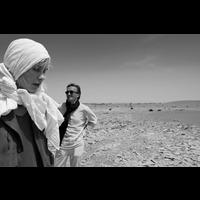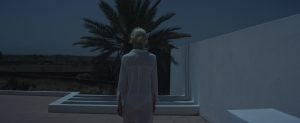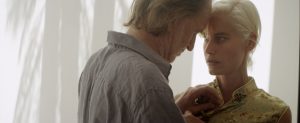NRFF interviews Dimitri de Clercq, Director of You Go To My Head

YOU GO TO MY HEAD
Directed by Dimitri de Clercq
 Producer turned filmmaker, Dimitri de Clercq began his producing career working with directors Mathieu Kassovitz (Café au Lait), Alain Robbe-Grillet (The Blue Villa) and Raúl Ruiz (The Golden Boat, Time Regained and Savage Souls). In 1993, he won an International Emmy Award for producing Ray Müller’s controversial documentary The Wonderful, Horrible Life of Leni Riefenstahl. A native Belgian, de Clercq grew up in the Middle East before majoring in film direction and production at New York University’s Tisch School of the Arts. In 2002, he started his own production company, CRM-114, named in homage to maverick filmmaker Stanley Kubrick. De Clercq’s fascination with the desert led him to produce several award-winning films set in desolate environments, including Afghan writer-director Atiq Rahimi’s Earth and Ashes (2005) and Iraqi director Mohamed Al-Daradji’s Son of Babylon (2009). The sepia-hued, parched wilderness of the desert was also a key inspiration for You Go To My Head, de Clercq’s feature film directorial debut. Interview by Massimo Barbato, Creative Director, NRFF.
Producer turned filmmaker, Dimitri de Clercq began his producing career working with directors Mathieu Kassovitz (Café au Lait), Alain Robbe-Grillet (The Blue Villa) and Raúl Ruiz (The Golden Boat, Time Regained and Savage Souls). In 1993, he won an International Emmy Award for producing Ray Müller’s controversial documentary The Wonderful, Horrible Life of Leni Riefenstahl. A native Belgian, de Clercq grew up in the Middle East before majoring in film direction and production at New York University’s Tisch School of the Arts. In 2002, he started his own production company, CRM-114, named in homage to maverick filmmaker Stanley Kubrick. De Clercq’s fascination with the desert led him to produce several award-winning films set in desolate environments, including Afghan writer-director Atiq Rahimi’s Earth and Ashes (2005) and Iraqi director Mohamed Al-Daradji’s Son of Babylon (2009). The sepia-hued, parched wilderness of the desert was also a key inspiration for You Go To My Head, de Clercq’s feature film directorial debut. Interview by Massimo Barbato, Creative Director, NRFF.
1. Congratulations on being a part of the 2018 edition of the New Renaissance Film Festival in London. How does it feel to be part of this summer’s programme?
We are thrilled to have been selected for this year’s edition of the New Renaissance Film Festival in London and to be included with such wonderful films. And honored to have our film nominated in several categories by the festival. We’re looking forward to the film’s premiere screening in London and to the Q&A with the audience.
2. What is the basic premise of You Go To My Head?
Following a mysterious car accident in the desert, Dafne (Delfine Bafort) suffers from post-traumatic amnesia. Jake (Svetozar Cvetković), the first person she sees when she regains consciousness, tells her he’s her husband.
3. What inspired you to make this film?
First and foremost, Delfine Bafort, the film’s lead actress. She is the soul and spirit behind You Go To My Head. She is the person who made me realize that the time had come for me to make a feature film of my own. I had been producing films, helping directors turn their dreams into realities. I’m Flemish like Delfine, but grew up primarily in the Middle East. I’ve often felt like a character out of a Wim Wenders film, someone without roots. When I first met Delfine in Morocco, while producing another film, I felt a longing for Belgium. She exhibited many of the characteristic traits of my native country and embodied so well the spirit of Jacques Brel’s song Le Plat Pays.
You Go To My Head also grew out of my life-long passion for the cinema and my convictions regarding the art and craft of filmmaking.
The sepia-hued, parched wilderness of the desert was also a key inspiration for the film.

4. How did you cast for the roles and prepare for the shoot?
The script for the film was written with Delfine Bafort in mind.
Svetozar Cvetković, who plays Jake, was approached with the shooting script by the film’s Serb co-producer (Zoran Tasic) only a few weeks prior to the start of principal photography. Svetozar was very taken by the story and immediately committed to playing the lead male role. He joined our film adventure with great enthusiasm and passion. You Go To My Head would not have been possible without him and his dedication to the film.
As a producer, I have always championed an independent cinema that remains true to the director’s personal vision, yet aims to reach and touch as wide an audience as possible. A lean form of filmmaking, with a compact crew passionately committed to making a film of quality and substance. So I launched You Go To My Head with those notions in mind.
My co-screenwriters and I approached the script in that same spirit. We wanted to tell a story that was suspenseful, tight and emotionally engaging within a solid narrative structure. Given our extremely limited resources, we wanted every euro to be on the screen. So we chose to tell a fairly unusual (yet extremely personal) love story that revolves around two principal characters and takes place in one primary interior location — a striking architect’s home I had access to in Marrakech. Yet, for our exteriors, we had the entire Moroccan landscape — sweeping deserts, dramatic seacoasts, vermillion mountains and lush forests.
5. What was the greatest challenge you faced in making You Go To My Head?
The late Stanley Kubrick evokes best the challenge of making a film in his D.W. Griffith Award acceptance speech to the Directors Guild of America: “… I’m in London making Eyes Wide Shut with Tom Cruise and Nicole Kidman and, just about this time, I’m probably in the car on the way to the studio. Which, as it happens, reminds me of a conversation I had with Steven Spielberg about what was the most difficult and challenging thing about directing a film. And I believe Steven summed it up about as profoundly as you can. He thought the most difficult and challenging thing about directing a film was getting out of the car. I’m sure you all know the feeling. But at the same time, anyone who has ever been privileged to direct a film also knows that, although it can be like trying to write War and Peace in a bumper car at an amusement park, when you finally get it right, there are not many joys in life that can equal the feeling…”.


6. What was the most rewarding aspect of making the film?
To craft the film with the cast and crew during principal photography. The 6-week shoot was a genuine, intense and rewarding collaboration. The film was shot entirely on location in Morocco, with a key crew of only four and a cast of three professional actors.
To sculpt the picture with the film’s editor and post-production team in Münich, Germany.
And today, to (re)discover the film through the eyes of the viewers has been a most enriching and moving experience. Audiences have been very receptive to the film. Great and passionate Q&A’s followed the movie’s screenings at the 39th Cairo International Film Festival and the 23d Belgrade Auteur Film Festival. The festival tour has been an amazing adventure.
7. Does the film have a central message (or emotion) you want to share with our audience?
I would like for the film to share with the audience an “aesthetic” emotion. The sensation of having experienced a daydream. And, for John Keats’ words “Was it a vision, or a waking dream” to find a new resonance after viewing the film.
Cinema is most often seen as a window onto the world. I’ve always perceived it more as a mirror into the human soul.
More than a modern “twisted” love story, the film is an act of love. I conceived it as a film-inspired “Taj Mahal,” a hymn, an ode, to the splendor of its actress Delfine Bafort.
I see You Go To My Head as a “dream” movie.

8. What are your future plans for this film and are there any others in the pipeline you can talk about?
To continue promoting You Go To My Head on the festival circuit and to preparing the film’s upcoming North American release.
As for my future projects, I am currently completing work on a script for a feature film that I would like to make in the United States.

